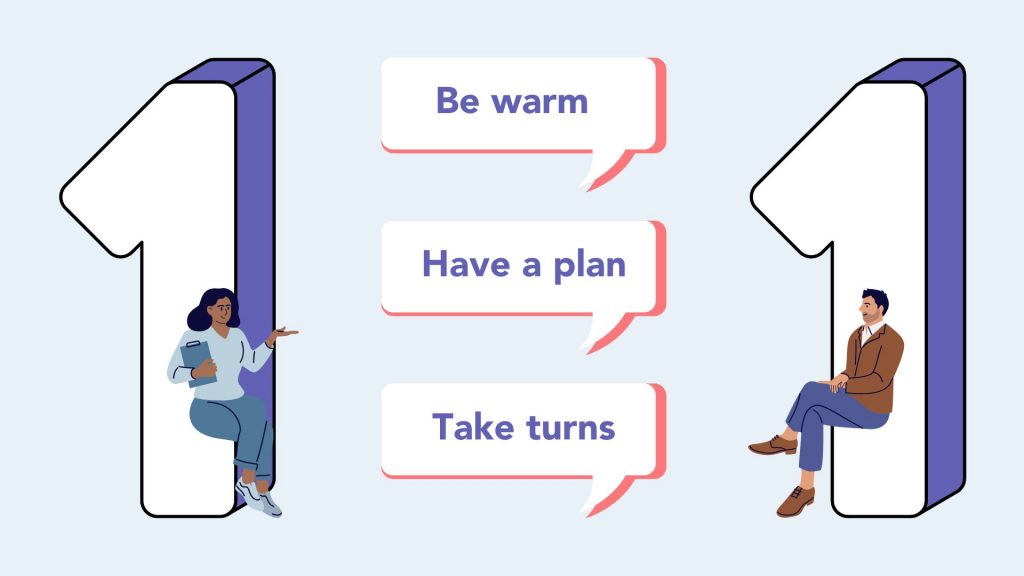At their best, 1-on-1 meetings allow for an opportunity to establish a trusting relationship with your peers and provide an opportunity to align on business goals and career objectives. Surveys have shown 75% of managers utilize 1-on-1 meetings as an opportunity to discuss development and growth with their employees.
1-on-1 meetings provide a dedicated space for employees and managers to align on expectations, pain points, and the overall communication required to drive business results. In order for 1-on-1 meetings to achieve this desired outcome, managers and HR teams must be intentional about how they approach and structure their meetings with employees. Here, we explore the benefits, strategies, and best practices for effective 1-on-1 meetings.
Benefits of 1-on-1 Meetings
Unlike team meetings, 1-on-1 meetings provide an opportunity for managers to hear directly from each employee on their team, and offer a personal relationship building opportunity that contributes to employee engagement.
1. Supports employee development
1-on-1 meetings are an excellent way to support employee development. Regular meetings between managers and employees help to identify areas where employees can improve their skills, knowledge, or expertise. During these meetings, managers can provide feedback, offer guidance, and provide the necessary resources to help employees achieve their goals, fostering a culture of continuous learning and growth.
2. Identifies pain points
1-on-1 meetings open up the opportunity to discuss any challenges your employees may be facing, and give you an eye into challenges you may otherwise not be aware of. Identifying pain points early on can help to prevent them from escalating into larger problems that can negatively impact employee morale and productivity. They’re also a great tool to help you develop performance review SMART goals to help employees reach their full potential.
3. Boosts employee engagement
Building relationships with employees can lead to the psychological safety and trust that breeds highly productive and engaged teams. When employees feel that they have a voice and their opinions are valued, they are more likely to be committed to their work. By providing a regular forum for open communication, managers can create a positive work environment where employees feel empowered to contribute to the company’s success.
4. Improves performance and boosts productivity
1-on-1 meetings help to set clear expectations and goals for employees. By providing regular feedback on progress, tracking performance, and addressing any issues or concerns, managers can help employees stay on track and ensure that they are meeting their objectives.1-on-1 meetings also help managers better understand their employee’s capacity, helping them manage their workload and remove any roadblocks helps employees feel motivated and set up for success, which can lead to increased productivity and better overall performance.
10 Steps to More Effective 1-on-1 Meetings
It will come as no surprise to you that meetings are more effective when you prepare for them. Taking the time to put these practices into place will boost the effectiveness of your 1-on-1 meetings, and deepen the connection you have with your team.
Before the Meeting
1. Schedule a time
Allow yourself and your employee to prepare for your 1-on-1 meeting by setting an agreed upon date and time that is convenient for a discussion. Doing so in advance will create the space to think about what you want to discuss, and help structure your work day in a way that is conducive to your workflow. Noone likes to be surprised by a meeting without prior notice.
2. Create an agenda
Take some time to reflect on the objectives you have for each employee, their performance, the overall team dynamic and any other relevant information that may inform your discussion. Then create an agenda that you can reference during the conversation to help keep you on topic. This exercise helps to jog your memory of any important topics you need to discuss as well as provides a focus and purpose to each 1-on-1 meeting.
3. Communicate with your employee
Once you’ve completed your agenda, share it with your employee prior to the meeting to give them an idea of what you will discuss in your 1-on-1 meeting. Be sure to give them ample time to review the agenda so they may prepare and reflect on specific topics. Encourage your employee to come with an agenda of their own as well to ensure each party has an opportunity to cover any pressing matters.
During the meeting
1. Break the ice
1-on-1 meetings don’t need to be strictly transactional. Remember this is an opportunity for you to connect with your employee and build a rapport. Begin the meeting by asking them how their weekend went or sharing a fun personal note like how your child won their football game or a new recipe you recently enjoyed. These conversations help ease any tension and bring a personal element that helps drive company culture.
2. Stick to your agenda
Once the conversation is warmed up, dive into your agenda and stick to it. It can be tempting to deviate into tangential topics, but doing so tends to run out the clock and distract you from the important matters you’ve agreed to discuss. If other important topics arise, make a note of them and revisit at the end of the meeting if you have time left over, or add it to the agenda for your next 1-on-1 meeting.
3. Offer a platform
It can’t be understated how crucial it is to give your employees an opportunity to raise their own thoughts and concerns during 1-on-1 meetings. 1-on-1’s are not a time for managers to talk at their employees and end the call, it should be a reciprocal conversation in which both parties have a chance to offer feedback, ask questions, and raise concerns. Be sure to offer ample time for employees to discuss their agenda points during the meeting.
4. Check in
Lastly, be sure to check in with your employee on their wellbeing. Ask about their workload, if they need support, what their recent challenges are, and encourage them to maintain a work-life balance. Doing so creates a safe space for employees to seek the support they may need, and shows your investment and care for your teams.

After the meeting
1. Document
During or directly after your 1-on-1 meeting take notes of what came up during the discussion. You and your employee are busy, and what you think will remain fresh in your mind can easily be forgotten after the meeting has concluded. Keeping notes will help you determine actionable next steps. This can also be a helpful tool to refer to when reflecting on your employee’s performance, and helps combat performance appraisal biases when it comes time for employee performance reviews.
2. Follow up
Depending on what was discussed in your 1-on-1 meeting, follow up with your employee with actionable next steps, support materials, or a general summary of your meeting. This helps keep the initiatives top of mind for both you and your employee, and serves as a reference point for projects and timelines.
3. Send an invite
At the end of your first 1-on-1 meeting discuss and schedule a time for your next meeting. This can be done once if you agree on a recurring time to meet, or can be decided upon at the end of each meeting. Either way, get something on the calendar right away to avoid missing a discussion and to give yourselves enough time to prepare for your next meeting.
Leveraging Automation for Employee Engagement
The outcome of your 1-on-1 meetings greatly depends on the effort you put in. If you give time and thought to how you prepare, execute, and follow up with your employees, their performance and engagement has a higher likelihood of improving.
After reading this article, you also know that it takes time to prepare for a truly effective 1-on-1 meeting. Don’t let the effort required discourage you from increasing your employee engagement. With the help of tools like Omni, you can digitize and automate the tedious parts of your employee management process to save time and see results.
Try a 14-day free trial to see for yourself how Omni can help transform your performance management practices.


